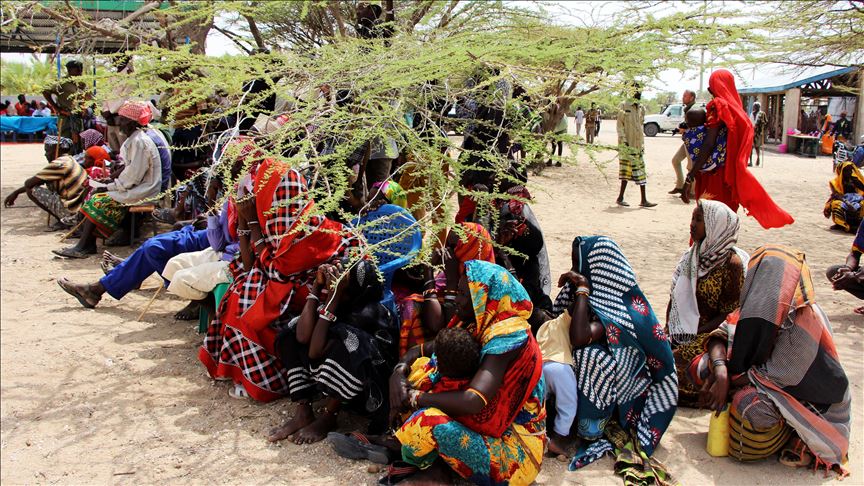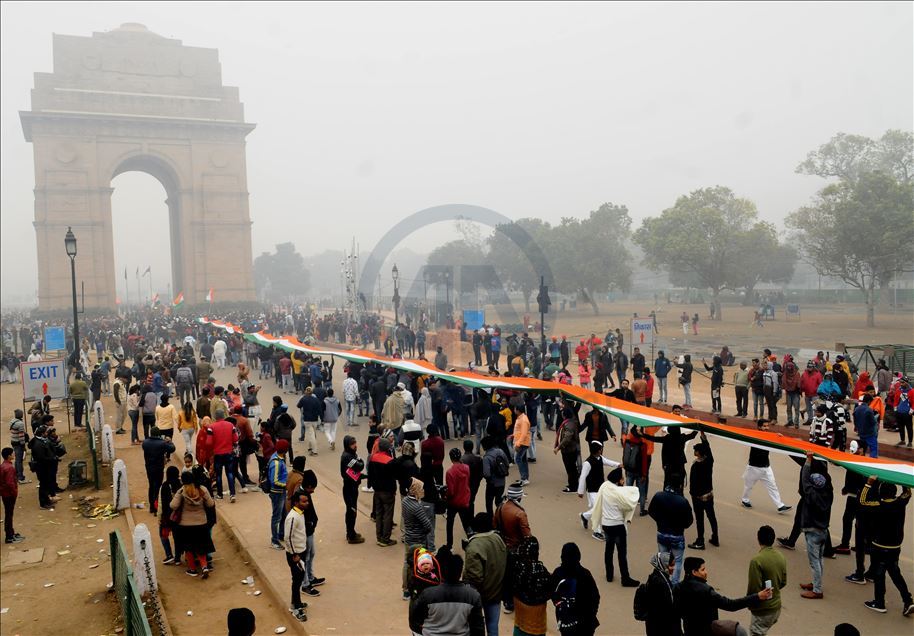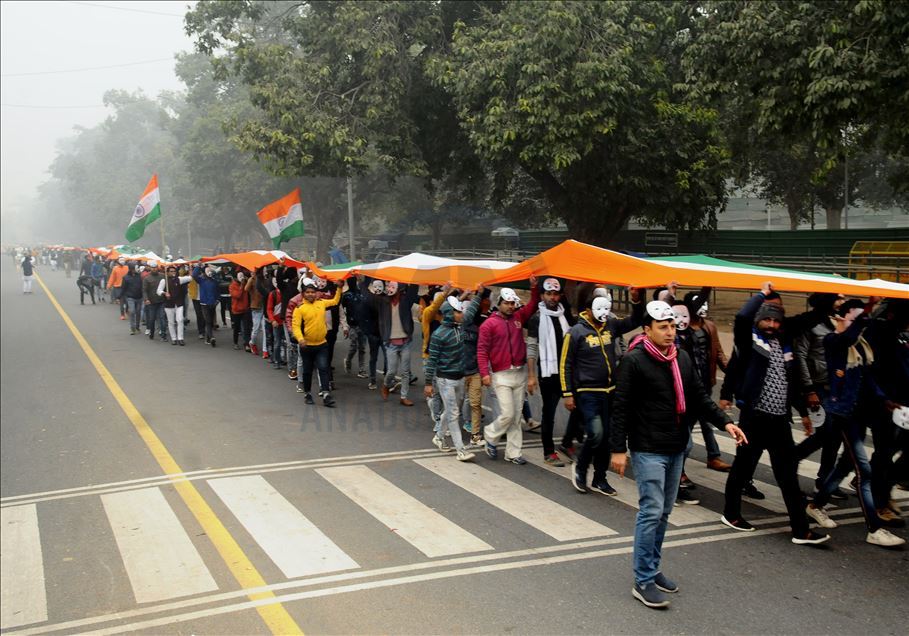It’s possible that I shall make an ass of myself. But in that case one can always get out of it with a little dialectic. I have, of course, so worded my proposition as to be right either way (K.Marx, Letter to F.Engels on the Indian Mutiny)
Wednesday, January 01, 2020

NAIROBI, Kenya
Northern Kenya is facing looming starvation after a recent invasion by locusts that originated from neighboring Somalia, officials said Tuesday.
Local authorities from the Wajir County Department of Agriculture told reporters that the locusts, coming from southern Somalia "moved around for close to two hours before settling eight to 10 kilometers away from Kutulo town."
Kutulo is roughly 45 kilometers (28 miles) from the Kenya-Somalia border.
Farmer Hassan Ahmed, 44, told Anadolu Agency: "The locusts have destroyed ready farm produce. The rains have been good and we have grasslands for our animals, but the locusts eat anything they find as long as its green."
Like many residents of the Wajir and Mandera counties who are mostly pastoralists, Ahmed said that the locusts were eating all the grass meant for the animals. "No pasture means a loss to our livelihood, we can't get enough milk from our animals and eventually they will die," he said.
According to the UN Food and Agriculture Organization (FAO) an outbreak of desert locusts in Somalia destroyed thousands of hectares of crops in, the worst such incident in over 25 years.
In a statement, the FAO said desert locusts continue to breed in Galmudug, Puntland and Somaliland, warning that an estimated 70,000 hectares of land have been infested by the insects, damaging crops and pastures in Ethiopia and Somalia.
---30---
NEW DELHI, INDIA - DECEMBER 30 : Protesters march towards the India Gate during a protest against the police brutality during the clashes, following days of violent protests across India against a new citizenship law, in Delhi, India on December 30, 2019.
PHOTO ESSAY
( Imtiyaz Khan - Anadolu Agency )





Tuesday, December 31, 2019
Chile: was a young woman murdered for photographing anti-government protests?
Albertina Martínez found dead two days after covering a protest in Santiago amid speculation she was targeted because of her job
Charis McGowan and John Bartlett in Santiago
Tue 31 Dec 2019

Albertina Martínez found dead two days after covering a protest in Santiago amid speculation she was targeted because of her job
Charis McGowan and John Bartlett in Santiago
Tue 31 Dec 2019

Albertina Martínez, who died in November.
No arrests have yet been made over her murder.
Photograph: Supplied
Photojournalists and press freedom activists have called on authorities in Chile to investigate the murder of a young photographer amid speculation that her death may have been linked to pictures she took during violent clashes between riot police and anti-government demonstrators.

Latin America's tumultuous year turns expectations on their head
The body of Albertina Martínez was found in her apartment in the Chilean capital, Santiago on 21 November, two days after she had been seen heading to a protest nearby. She had been beaten, and a bag containing her camera, laptop and phone were missing.
“The pictures she took that day have vanished,” said her sister, Priscilla.
Sources close to the investigation say the case is being treated as a robbery with homicide, but the timing of the murder has prompted speculation that Martínez was targeted because she had been photographing the protests.
“Chilean authorities should investigate the killing of Albertina Martínez Burgos thoroughly to determine if it was linked to her reporting, and do everything possible to recover her equipment and materials,” said Natalie Southwick from the Committee to Protect Journalists.
In more than two months of mass demonstrations against social and economic inequality, thousands have been injured and at least 27 people have died.
No arrests have yet been made over Martínez’s murder, and with the motive still unclear, friends and authorities have urged caution.
FacebookTwitterPinterest Friends from Martínez’s football team have said she was afraid to attend the protests. Photograph: Supplied
Friends from her football team have said she was afraid to attend the protests, but pictures on Martínez’s private Instagram feed from the week before her death show masked protesters shrouded in billowing clouds of smoke.
Martínez moved to Santiago from southern Chile 10 years ago to pursue a career in photography, working at Chile’s main daily, El Mercurio. She then moved on to work as a lighting assistant at a television studio.
“She was clearly happier taking pictures than working at the studio, and she had a good eye for photography, but opportunities in the field can be difficult to come by,” said Sergio López, who worked alongside Martínez at the newspaper.
He had spoken to her the week before her death. “She said she enjoyed taking pictures at the protests, even though she was a little afraid,” he said.
Photojournalists group Frente Fotograficó responded to Martínez’s death by sharing her pictures of the protests, along with the hashtag #JUSTICIAPARAALBERTINA.
“We will not forget her face or her name,” they wrote.
The photojournalism collective Migrar Photo called on investigators for transparency and truth, and warned photographers to “look after one another”.
The group said that police animosity towards photographers has intensified in recent weeks, as coverage of protests has provided evidence of human rights abuses by the security forces. Members of the group have received threats from the police, and have been shot with pellets, teargas and water cannons.
Chile is considered a safe country for journalists, ranked 46th out of 180 countries in the Reporters Without Borders 2019 World Press Freedom Index.
But since the unrest began 10 weeks ago, RSF has condemned a series of attacks on the press, including forced detention.
Freelance photographer Giovanny Valenzuela was covering the same protest as Martínez on 19 November, and described a heavy police presence and “strong repression”.

Chilean air force chief says cause of Antarctic plane crash may never be known
Read more
He said news of her death and shaken other photojournalists covering the protests.
“The fact that we are in the middle of a social revolt, and a photographer was found dead without her equipment was very shocking. We feel threatened – and very sad.”
Other attacks on press include an incident in which a BBC team was apparently targeted with teargas rounds, the detention of two photojournalists, and a police assault on an Argentinian journalist who was hit in the face with a baton by officers who then destroyed her camera.
Martínez’s sister Priscilla said she had still not been contacted by prosecutors. “I can’t rule out anything because I don’t know anything,” she said.
Photojournalists and press freedom activists have called on authorities in Chile to investigate the murder of a young photographer amid speculation that her death may have been linked to pictures she took during violent clashes between riot police and anti-government demonstrators.

Latin America's tumultuous year turns expectations on their head
The body of Albertina Martínez was found in her apartment in the Chilean capital, Santiago on 21 November, two days after she had been seen heading to a protest nearby. She had been beaten, and a bag containing her camera, laptop and phone were missing.
“The pictures she took that day have vanished,” said her sister, Priscilla.
Sources close to the investigation say the case is being treated as a robbery with homicide, but the timing of the murder has prompted speculation that Martínez was targeted because she had been photographing the protests.
“Chilean authorities should investigate the killing of Albertina Martínez Burgos thoroughly to determine if it was linked to her reporting, and do everything possible to recover her equipment and materials,” said Natalie Southwick from the Committee to Protect Journalists.
In more than two months of mass demonstrations against social and economic inequality, thousands have been injured and at least 27 people have died.
No arrests have yet been made over Martínez’s murder, and with the motive still unclear, friends and authorities have urged caution.
FacebookTwitterPinterest Friends from Martínez’s football team have said she was afraid to attend the protests. Photograph: Supplied
Friends from her football team have said she was afraid to attend the protests, but pictures on Martínez’s private Instagram feed from the week before her death show masked protesters shrouded in billowing clouds of smoke.
Martínez moved to Santiago from southern Chile 10 years ago to pursue a career in photography, working at Chile’s main daily, El Mercurio. She then moved on to work as a lighting assistant at a television studio.
“She was clearly happier taking pictures than working at the studio, and she had a good eye for photography, but opportunities in the field can be difficult to come by,” said Sergio López, who worked alongside Martínez at the newspaper.
He had spoken to her the week before her death. “She said she enjoyed taking pictures at the protests, even though she was a little afraid,” he said.
Photojournalists group Frente Fotograficó responded to Martínez’s death by sharing her pictures of the protests, along with the hashtag #JUSTICIAPARAALBERTINA.
“We will not forget her face or her name,” they wrote.
The photojournalism collective Migrar Photo called on investigators for transparency and truth, and warned photographers to “look after one another”.
The group said that police animosity towards photographers has intensified in recent weeks, as coverage of protests has provided evidence of human rights abuses by the security forces. Members of the group have received threats from the police, and have been shot with pellets, teargas and water cannons.
Chile is considered a safe country for journalists, ranked 46th out of 180 countries in the Reporters Without Borders 2019 World Press Freedom Index.
But since the unrest began 10 weeks ago, RSF has condemned a series of attacks on the press, including forced detention.
Freelance photographer Giovanny Valenzuela was covering the same protest as Martínez on 19 November, and described a heavy police presence and “strong repression”.

Chilean air force chief says cause of Antarctic plane crash may never be known
Read more
He said news of her death and shaken other photojournalists covering the protests.
“The fact that we are in the middle of a social revolt, and a photographer was found dead without her equipment was very shocking. We feel threatened – and very sad.”
Other attacks on press include an incident in which a BBC team was apparently targeted with teargas rounds, the detention of two photojournalists, and a police assault on an Argentinian journalist who was hit in the face with a baton by officers who then destroyed her camera.
Martínez’s sister Priscilla said she had still not been contacted by prosecutors. “I can’t rule out anything because I don’t know anything,” she said.
---30---
CIA devised way to restrict missiles given to allies, researcher says
LEIPZIG, Germany (Reuters) - The U.S. Central Intelligence Agency has devised technology to restrict the use of anti-aircraft missiles after they leave American hands, a researcher said, a move that experts say could persuade the United States that it would be safe to disseminate powerful weapons more frequently.
The new technology is intended for use with shoulder-fired missiles called Man-Portable Air-Defense Systems (MANPADS), Dutch researcher Jos Wetzels told a cybersecurity conference here in Leipzig, Germany on Saturday. Wetzels said the system was laid out in a batch of CIA documents published by WikiLeaks in 2017 but that the files were mislabeled and attracted little public attention until now.
Wetzels said the CIA had come up with a “smart arms control solution” that would restrict the use of missiles “to a particular time and a particular place.” The technique, referred to as “geofencing,” blocks the use of a device outside a specific geographic area.
Weapons that are disabled when they leave the battlefield could be an attractive feature. Supplied to U.S. allies, the highly portable missiles can help win wars, but they have often been lost, sold, or passed to extremists.
For example, Stinger MANPADS supplied by the United States are credited with helping mujahedeen rebels drive Soviet forces out of Afghanistan in a conflict that spanned the 1980s and 1990s. But U.S. officials have since spent billions of dollars here to clear the missiles from the country - and from other conflict zones around the world.
Wetzels said it was unclear whether the CIA’s design ever left the drawing board or where it was meant to have been deployed, but he noted that the apparent period of development in the documents’ metadata - 2014 to 2015 - roughly coincided with media reports about the deployment of MANPADS to rebels in Syria. Geofencing might have been seen as a way of ensuring the missiles were used on the Syrian battlefield and nowhere else, he said.
The CIA declined to comment.
Outside experts who reviewed Wetzels’ analysis said they found it plausible.
N.R. Jenzen-Jones, who directs the British-based ARES intelligence consultancy, said geofencing has long been discussed as a safeguard to allow powerful weapons “into the hands of friendly forces operating in high-risk environments.”
Wetzels said geofencing was no panacea, running through a list of security vulnerabilities that could be used by insurgents to bypass the restrictions.
“It’s not a watertight solution,” he said.
LEIPZIG, Germany (Reuters) - The U.S. Central Intelligence Agency has devised technology to restrict the use of anti-aircraft missiles after they leave American hands, a researcher said, a move that experts say could persuade the United States that it would be safe to disseminate powerful weapons more frequently.
The new technology is intended for use with shoulder-fired missiles called Man-Portable Air-Defense Systems (MANPADS), Dutch researcher Jos Wetzels told a cybersecurity conference here in Leipzig, Germany on Saturday. Wetzels said the system was laid out in a batch of CIA documents published by WikiLeaks in 2017 but that the files were mislabeled and attracted little public attention until now.
Wetzels said the CIA had come up with a “smart arms control solution” that would restrict the use of missiles “to a particular time and a particular place.” The technique, referred to as “geofencing,” blocks the use of a device outside a specific geographic area.
Weapons that are disabled when they leave the battlefield could be an attractive feature. Supplied to U.S. allies, the highly portable missiles can help win wars, but they have often been lost, sold, or passed to extremists.
For example, Stinger MANPADS supplied by the United States are credited with helping mujahedeen rebels drive Soviet forces out of Afghanistan in a conflict that spanned the 1980s and 1990s. But U.S. officials have since spent billions of dollars here to clear the missiles from the country - and from other conflict zones around the world.
Wetzels said it was unclear whether the CIA’s design ever left the drawing board or where it was meant to have been deployed, but he noted that the apparent period of development in the documents’ metadata - 2014 to 2015 - roughly coincided with media reports about the deployment of MANPADS to rebels in Syria. Geofencing might have been seen as a way of ensuring the missiles were used on the Syrian battlefield and nowhere else, he said.
The CIA declined to comment.
Outside experts who reviewed Wetzels’ analysis said they found it plausible.
N.R. Jenzen-Jones, who directs the British-based ARES intelligence consultancy, said geofencing has long been discussed as a safeguard to allow powerful weapons “into the hands of friendly forces operating in high-risk environments.”
Wetzels said geofencing was no panacea, running through a list of security vulnerabilities that could be used by insurgents to bypass the restrictions.
“It’s not a watertight solution,” he said.
---30---
Uber, Postmates sue to block California gig worker law, claiming it's unconstitutional
(Reuters) - Ride-hailing company Uber Technologies Inc and courier services provider Postmates Inc asked a U.S. court to block a California labor law set to go into effect on Wednesday, arguing the bill violates the U.S. Constitution.
In a lawsuit filed in Los Angeles federal court on Monday, the companies and two app-based drivers said the law, which would make it harder for gig economy companies to qualify their workers as independent contractors rather than employees, was irrational, vague and incoherent.
The office of California Attorney General Xavier Becerra said in a statement on Monday it was reviewing the complaint. The bill, called AB5, faces multiple legal challenges.
The law was signed by California Governor Gavin Newsom in September and has garnered national attention, largely owing to the size of California’s workforce and the state’s leadership role in establishing policies that are frequently adopted by other states.
Backers of the bill, including labor groups, have argued the law protects workers’ rights. By classifying the contractors as employees, the companies would be subject to labor laws that require higher pay and other benefits such as medical insurance.
The bill strikes at the heart of the “gig economy” business model of technology platforms like Uber, Postmates, Lyft Inc, DoorDash and others who rely heavily on the state’s 450,000 contract workers, not full-time employees, to drive passengers or deliver food via app-based services.
Uber, Postmates and other app-based companies said the legislation compromises the flexibility prized by their workforce, and that fewer workers would be hired were they considered employees.
The companies in their Monday lawsuit called AB5 a “thinly veiled attempt” to target and harm gig economy businesses. Singling out app-based workers violates equal protection guaranteed under the constitutions of the United States and California, the companies argued.
“It irreparably harms network companies and app-based independent service providers by denying their constitutional rights to be treated the same as others to whom they are similarly situated,” the lawsuit said.
The companies pointed to allegedly arbitrary exemptions of different non-gig worker groups, including salespeople, travel agents, construction truck drivers and commercial fishermen.
The full impact of the bill remains unclear in the short term, but the lawsuit cited a study saying the bill would increase ride-hailing company Lyft’s operating costs by 20% and lead to some 300,000 fewer drivers in California.
Ron Herrera, secretary-treasurer of Teamsters Local 396 and Teamsters International vice president, said in a statement late on Monday night, that the labour union objects the lawsuit challenging the constitutionality of AB-5.
“Teamsters Local 396 and the broader American Labor Movement must use all of the resources at our disposal to ensure that AB-5 is protected and that workers have a voice at the table,” Herrera added.
Uber, Lyft and food delivery company DoorDash have earmarked $90 million for a planned November 2020 ballot initiative that would exempt them from the law.
(Reuters) - Ride-hailing company Uber Technologies Inc and courier services provider Postmates Inc asked a U.S. court to block a California labor law set to go into effect on Wednesday, arguing the bill violates the U.S. Constitution.
In a lawsuit filed in Los Angeles federal court on Monday, the companies and two app-based drivers said the law, which would make it harder for gig economy companies to qualify their workers as independent contractors rather than employees, was irrational, vague and incoherent.
The office of California Attorney General Xavier Becerra said in a statement on Monday it was reviewing the complaint. The bill, called AB5, faces multiple legal challenges.
The law was signed by California Governor Gavin Newsom in September and has garnered national attention, largely owing to the size of California’s workforce and the state’s leadership role in establishing policies that are frequently adopted by other states.
Backers of the bill, including labor groups, have argued the law protects workers’ rights. By classifying the contractors as employees, the companies would be subject to labor laws that require higher pay and other benefits such as medical insurance.
The bill strikes at the heart of the “gig economy” business model of technology platforms like Uber, Postmates, Lyft Inc, DoorDash and others who rely heavily on the state’s 450,000 contract workers, not full-time employees, to drive passengers or deliver food via app-based services.
Uber, Postmates and other app-based companies said the legislation compromises the flexibility prized by their workforce, and that fewer workers would be hired were they considered employees.
The companies in their Monday lawsuit called AB5 a “thinly veiled attempt” to target and harm gig economy businesses. Singling out app-based workers violates equal protection guaranteed under the constitutions of the United States and California, the companies argued.
“It irreparably harms network companies and app-based independent service providers by denying their constitutional rights to be treated the same as others to whom they are similarly situated,” the lawsuit said.
The companies pointed to allegedly arbitrary exemptions of different non-gig worker groups, including salespeople, travel agents, construction truck drivers and commercial fishermen.
The full impact of the bill remains unclear in the short term, but the lawsuit cited a study saying the bill would increase ride-hailing company Lyft’s operating costs by 20% and lead to some 300,000 fewer drivers in California.
Ron Herrera, secretary-treasurer of Teamsters Local 396 and Teamsters International vice president, said in a statement late on Monday night, that the labour union objects the lawsuit challenging the constitutionality of AB-5.
“Teamsters Local 396 and the broader American Labor Movement must use all of the resources at our disposal to ensure that AB-5 is protected and that workers have a voice at the table,” Herrera added.
Uber, Lyft and food delivery company DoorDash have earmarked $90 million for a planned November 2020 ballot initiative that would exempt them from the law.
---30---
Subscribe to:
Posts (Atom)



